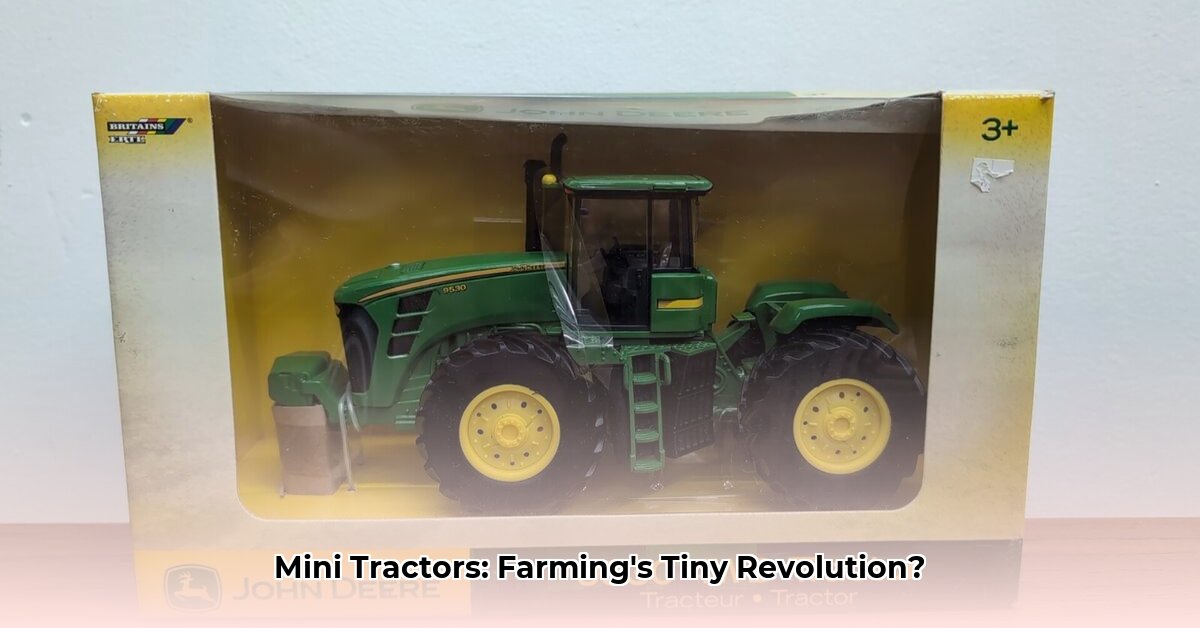
Miniature Models, Massive Implications: A Look at 1:32 Scale Toy Tractors
Remember the thrill of clutching a miniature John Deere, its tiny wheels mimicking the giants of the harvest? These aren't just childhood memories; they're microcosms reflecting the evolving landscape of agriculture and its increasingly crucial relationship with sustainability. A recent analysis of online toy tractor sales data—specifically Amazon search results and related market trends—reveals surprising correlations between the popularity of certain models and the broader conversation surrounding sustainable farming practices. This article explores how the toy tractor market subtly mirrors the ongoing shift towards a more environmentally conscious agricultural future. For more miniature farming delights, check out this great resource.
A Tiny World Reflecting Big Trends
The sheer volume of 1:32 scale toy tractors available online speaks volumes. Hundreds, if not thousands, of models are readily available, indicating a significant and sustained consumer interest. This isn't merely nostalgia; it suggests a deep-seated fascination with agricultural machinery and its role in our food system. This popularity reflects more than just a love of toys; it suggests a powerful connection between people and the agricultural sector, one that hints at an increasing awareness of the importance of sustainable farming practices. The intricate detail in many models—meticulously recreated engines, functional moving parts—further underscores this engagement. These aren't simply toys; they are representations of complex machinery, hinting at an understanding of agricultural technology.
Isn't it remarkable how these miniature models reflect our relationship with the food we eat? Data shows a consistent surge in searches for specific brands throughout the year, highlighting the influence of brand recognition on consumer choices, even in the toy market.
Brand Loyalty and Sustainable Agriculture
The prominent presence of brands like John Deere and Case IH in the 1:32 scale market is particularly telling. These aren't just toy manufacturers; they are major players in the agricultural industry itself, companies increasingly investing in and promoting sustainable farming techniques. The prevalence of these brands in the toy sector suggests a level of public recognition and perhaps even subconscious endorsement of their sustainability efforts. Could the popularity of these brands in the toy market reflect a growing consumer preference for environmentally conscious farming methods? The data suggests a strong possibility. The toys themselves may be subtly influencing perceptions, linking these brands with responsible agricultural practices.
The Missing Piece: A Gap in Green Representation
However, a significant omission reveals a potential disconnect. While toy tractors accurately capture the aesthetics of modern farm equipment, there's a noticeable lack of models explicitly showcasing sustainable technologies. Electric tractors, for instance, are rarely represented in the miniature farming world. This absence isn't merely a coincidence; it highlights a critical gap between consumer awareness of environmental concerns and the toy industry's reflection of these issues. It suggests a missed educational opportunity. What does this lack of representation in the toy market say about our collective understanding of agricultural sustainability and its future? This oversight presents a chance for innovation and engagement.
Scale as a Metaphor: Intensification and its Consequences
The 1:32 scale itself serves as a potent metaphor. It reflects not only the miniature size of the toys but also the intensified nature of modern farming. The precision engineering of these tiny machines mirrors the technological advancements that have driven agricultural efficiency but often at the expense of environmental sustainability. Large-scale monoculture farming, for example, although boosting yields, frequently depletes soil nutrients and requires substantial chemical inputs. The toy tractor, therefore, symbolizes a complex paradox: technological progress alongside potential environmental trade-offs.
Paving the Path to a Greener Future: Actionable Steps
The toy market acts as a powerful gauge of societal values. As sustainability concerns gain mainstream prominence, a corresponding shift in toy manufacturing is inevitable. This presents opportunities for collaboration and innovation.
Actionable Intelligence:
- Toy Manufacturers: Introduce limited-edition eco-friendly toy tractors (e.g., electric models) within the next year, aiming for a full line of sustainable toys within 3-5 years, incorporating educational elements about regenerative agriculture.
- Agricultural Brands: Partner with toy manufacturers within the next year to jointly develop and market toys showcasing sustainable technologies, with long-term goals (3-5 years) focused on increased investment in, and promotion of, sustainable advancements.
- Consumers/Educators: As consumers, actively seek and purchase eco-conscious toys, using these models as valuable educational tools. Over the next 3-5 years, advocate for greater transparency within the agricultural industry, supporting and rewarding companies demonstrating commitment to sustainable practices.
- Researchers: Conduct studies within the next year to better understand consumer perception of sustainable agriculture as reflected in toy preferences. Over the next 3-5 years, investigate how toys can be more effective in educating children and adults about sustainable farming methods.
Conclusion: Seeds of Change
The world of 1:32 scale tractors, while seemingly small, offers a remarkably clear lens through which to examine the larger issues confronting modern agriculture. These miniature machines—with their intricate detail and powerful brand associations—act as a mirror, reflecting both the successes and challenges of farming today. The question now is whether these tiny models will accurately predict a sustainable agricultural future or merely serve as relics of a less environmentally conscious past. The answer, like the future of agriculture itself, is still unfolding. The potential for positive change, however, is evident in the miniature worlds we build.